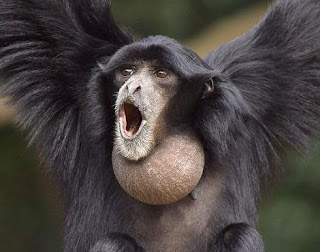Animal Wildlife | Gibbon | The gibbon is a small sized ape, found inhabiting the dense jungles and tropical rainforests across south-east Asia. Gibbons belong to the lesser ape family which are closely related to the great apes (chimpanzees, orang-utans, bonobos, gorillas and humans). Gibbons are small and lightweight monkeys that grow to around 90cm tall and weigh just 7kg. The lightweight body of the gibbons means that the gibbon is able to move around in and leap between the trees.
Gibbons are arboreal animals which means that they spend the majority of their lives in the trees. Living in the trees has it's advantages for the gibbon as the gibbon has plenty of food and is also a safe distance above ground from predators. There are more than 10 different species of gibbon living in the trees from northern India and the islands of Indonesia. All the gibbon species are fairly similar in shape and size, but the different species of gibbon differ most in their colours which range from grey, to brown, to black. Some species of gibbon are identified by the white markings on their faces.
Gibbons have very long arms which are often longer than the gibbon's legs. Gibbons use their arms to help them to move around in the trees and to balance whilst they are walking along branches. Gibbons are known to be the fastest, non-flying tree dwelling mammals in the world as they can move at speeds of up to 35mph and are able to swing themselves 15 meters from tree to tree. Gibbons are also incredible at leaping and can leap long distances of up to 8 meters. Like all other species of ape, gibbons do not have a tail. Gibbons are omnivorous animals meaning that they eat a mixture of both plant and animal matter. The main food of the gibbon is ripe fruit which grow around them in the trees, and makes up around three quarters of the gibbon's diet. Gibbons also prey on insects, eggs, spiders and small birds and reptiles.
Due to their tree-dwelling nature, gibbons have few natural predators in their environment apart from those that can also get up the tall trees. Leopards, large snakes and birds of prey are the main predators of the gibbon. Gibbons live in groups, known as troops which consists of the alpha male and female, and their offspring. Gibbons mates usually stay together for life and the female gibbon gives birth to a single baby gibbon after a gestation period of around 7 months. The male gibbon and the female gibbon look after the baby gibbon until it is about a year old, but the baby gibbon usually stays close to it's mother until it is older (between 6 and 7) and is able to start a family of it's own.
Nearly all of the different species of gibbon are today considered to be either threatened or extinction mainly due to deforestation and habitat loss.
Tags: gibbon reporter, agile gibbon, silvery gibbon, gibbon primate, gibbon packing, barbara gibbon, gibbon center, adopt a gibbon, laos gibbon experience, the gibbon experience, gibbon conservation, gibbon experience, radio gibbon, gibbon project, pileated gibbon, gibbon endangered, gibbon ne, edward gibbon bathrooms, gibbon nebraska







0 Response to "Gibbon"
Post a Comment